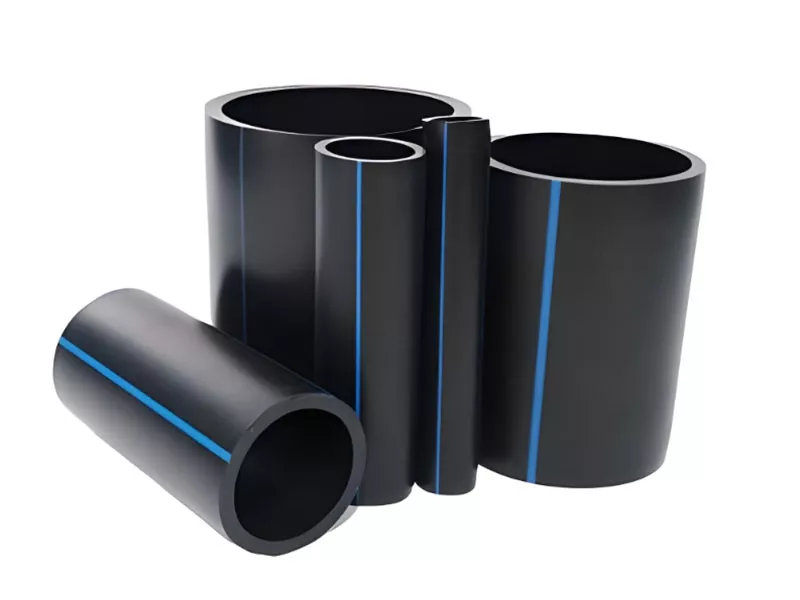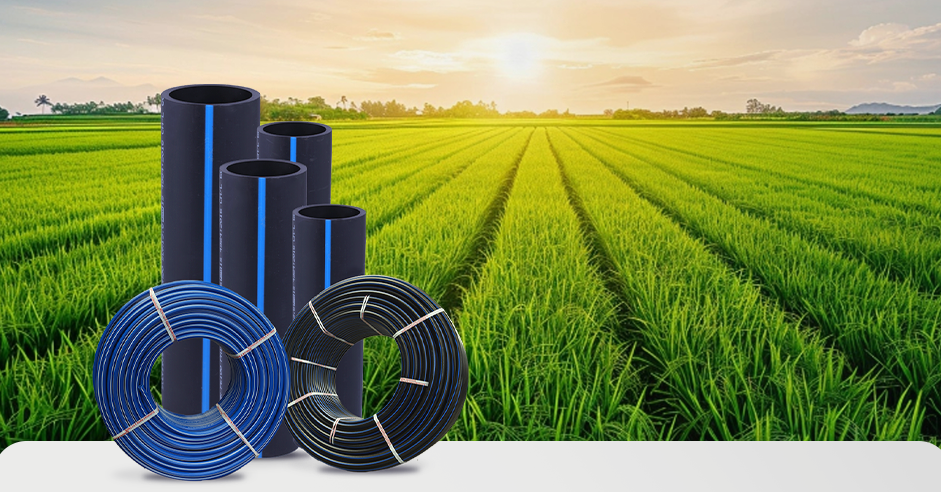How Midland TX HDPE Pipe Fittings in Stock Enable Faster Builds
Wiki Article
Check Out the Manufacturing Refine Behind High-Quality HDPE Pipeline and Its Applications
The production procedure of premium HDPE pipelines is complex and systematic. It starts with the option of raw products that improve efficiency. Following this, ethylene undergoes polymerization to form resin, which is after that formed via extrusion. Quality assurance is critical, making sure that the last item fulfills rigorous standards. Nevertheless, the trip of HDPE pipelines doesn't end with production. Their applications across various markets expose a broader significance worth examining.Understanding HDPE: Properties and Advantages

High-density polyethylene (HDPE) is a versatile polycarbonate understood for its toughness and resistance to various ecological aspects. This material exhibits excellent tensile strength, making it appropriate for demanding applications. Its low-density framework adds to a lightweight item, assisting in simplicity of dealing with and installation. HDPE additionally showcases exceptional resistance to chemicals, which lessens deterioration when exposed to rough substances.
The product's low wetness absorption further enhances its long life, making it ideal for usage in pipes and storage tanks. In addition, HDPE is immune to ultraviolet (UV) radiation, guaranteeing that products preserve their stability even when revealed to sunshine. Its flexibility enables for the production of elaborate shapes without endangering strength. The green nature of HDPE, commonly stemmed from recycled products, includes to its charm, promoting lasting techniques in manufacturing. In general, these homes and advantages make HDPE a preferred selection for numerous industrial and consumer applications.
Raw Product Choice for HDPE Manufacturing
The option of raw products for HDPE production is important to validate the end product satisfies the desired specs and quality criteria. High-density polyethylene (HDPE) is primarily created from polymerized ethylene, obtained from fossil gas such as all-natural gas or unrefined oil. The quality of these feedstocks greatly influences the mechanical and thermal properties of the final HDPE.Ingredients likewise play a considerable duty in boosting HDPE's efficiency, consisting of anti-oxidants, UV stabilizers, and colorants, which improve resilience and resistance to environmental variables. The selection procedure must think about not just the chemical structure of the raw materials however likewise their handling attributes to guarantee effective production.
The sourcing of raw products need to prioritize sustainability and conformity with environmental laws, as accountable techniques are critical in today's market. Eventually, cautious raw material option lays the foundation for creating high-grade HDPE pipelines suitable for diverse applications.
The Extrusion Refine: Forming HDPE Pipe
The extrusion procedure plays an essential role fit HDPE pipes, starting with precise product prep work methods that ensure suitable flow and uniformity. Equally vital is the design of the die, which directly affects the final measurements and surface high quality of the pipeline. Together, these variables contribute greatly to the effectiveness and quality of HDPE pipeline production.Product Prep Work Strategies
Efficient production of HDPE pipelines starts with meticulous product prep work strategies, especially the extrusion process. During this stage, high-density polyethylene resin is initial dried out to eliminate moisture, guaranteeing perfect flow attributes. The material is after that fed right into the extruder, where it undertakes home heating and melting, transforming into a viscous state. This home heating procedure is thoroughly regulated to preserve the material's integrity and efficiency. The molten HDPE is compelled through a die, shaping it right into a continuous pipe form. Correct temperature monitoring throughout extrusion is essential, as it straight impacts the product's residential or commercial properties and the last product quality. When formed, the HDPE pipe is cooled and cut to defined sizes, all set for succeeding processing and applications.Die Style Relevance
Precision in die design plays a necessary function in the extrusion process of HDPE pipelines. The die offers as the last shaping device, straight affecting the pipe's dimensions, wall surface thickness, and surface finish. A properly designed die warranties uniform material circulation, lowering problems such as abnormalities and weak points. The geometry of the die should be maximized to fit the particular residential or commercial properties of HDPE, including its thickness and thermal habits throughout extrusion. Furthermore, the cooling rate of the product as it passes with the die can markedly influence the pipe's architectural honesty. Spending in innovative die modern technology is crucial for makers aiming to produce high-grade HDPE pipelines that meet industry standards and client expectations.Top Quality Control Steps in HDPE Production
Various aspects influence the quality of HDPE pipeline production, effective high quality control actions are critical to guarantee uniformity and integrity in the final product (Pipe Manufacturing Midland TX). Key top quality control techniques consist of extensive material assessment, confirming that the raw polyethylene meets recognized criteria for pureness and thickness. Throughout the extrusion process, parameters such as temperature, pressure, and cooling time are carefully monitored to keep dimensional precision and architectural stabilityAdditionally, post-production screening is necessary; producers usually conduct hydrostatic tests to assess the pipeline's stamina and resistance to pressure. Aesthetic inspections for surface defects additionally enhance quality assurance. Qualification from relevant criteria organizations, like ASTM or ISO, supplies an added layer of reliability. By implementing these detailed quality assurance steps, manufacturers can lessen defects, improve performance, and guarantee that the HDPE pipes meet the specific requirements of numerous applications, eventually resulting in customer fulfillment and depend on in the product.
Applications of HDPE Pipeline Throughout Industries
HDPE pipelines are utilized throughout different sectors due to their durability and adaptability. In water circulation systems, they guarantee effective shipment, while in wastewater administration, they offer trustworthy services for waste transport. In addition, agricultural watering networks benefit from HDPE's resistance to corrosion and versatility, making it an optimal selection for modern-day farming practices.
Water Circulation Solutions
A significant number of sectors count on high-density polyethylene (HDPE) pipes for efficient water distribution systems. Known for their resilience and resistance to rust, HDPE pipelines are extensively used in municipal water networks, farming irrigation, and commercial applications. Their lightweight nature facilitates simple handling and installment, decreasing labor prices and time. Furthermore, HDPE pipes can suit various pressure levels, making them suitable for both reduced and high-pressure systems. Pipe Supplier American Plastics Midland. The versatility of the product permits smooth assimilation into existing facilities, lessening the demand for comprehensive excavation. In addition, HDPE's resistance to chemical seeping assurances that the water provided stays safe and clean, making it a suitable choice for maintaining the high quality of potable water across numerous fieldsWastewater Administration Solutions
Reliable water circulation systems additionally lead the way for cutting-edge wastewater management services, where high-density polyethylene (HDPE) pipelines play a significant role. Prominent for their resilience and resistance to deterioration, HDPE pipes are suitable for carrying wastewater in different setups. Their adaptability enables easy installation in intricate environments, lessening the demand for extensive excavation. Additionally, HDPE's smooth interior surface minimizes friction, enhancing flow prices and performance. These pipes are also immune to chemical leaching, making certain that impurities do not jeopardize the surrounding environment. Industries, towns, and therapy centers significantly rely upon HDPE pipes for their reliability and long life, making them a recommended selection for modern-day wastewater monitoring systems. This flexibility emphasizes the essential relevance of HDPE pipelines across many applications.Agricultural Irrigation Networks
Agricultural watering networks benefit significantly from using high-density polyethylene (HDPE) pipes, which offer reliable and trustworthy water delivery to plants. HDPE pipes are lightweight, making them very easy to move and mount, while their versatility enables different arrangements in diverse terrains. These pipelines demonstrate superb resistance to deterioration, chemicals, and UV radiation, making sure resilience in rough farming settings. In addition, their smooth indoor surface decreases friction loss, enhancing water circulation and reducing energy expenses related to pumping. The durability of HDPE pipes, typically going beyond half a century, adds to lower upkeep and replacement costs. Farmers increasingly depend on HDPE pipelines to boost watering efficiency and promote lasting farming techniques, ultimately leading to enhanced crop returns and source conservation.
Future Fads in HDPE Pipe Technology
As the need for sustainable and effective infrastructure grows, innovations in HDPE pipe innovation are positioned to change numerous sectors. Emerging patterns consist of the assimilation of smart modern technologies, such as sensors and IoT capacities, which promote real-time monitoring of pipe problems, reducing maintenance expenses and protecting against leaks. In addition, the development of sophisticated manufacturing strategies, such as 3D printing, is allowing the production of complex, personalized pipe styles that deal with certain task demands.The focus on recycling and round economic climate methods is driving the advancement of HDPE pipelines made from recycled materials, boosting sustainability. Enhanced jointing techniques, such as electro-fusion and mechanical fittings, are additionally boosting installment effectiveness and dependability. The growing emphasis on environmental regulations is pushing producers to take on greener production procedures, guaranteeing that HDPE pipelines not just meet sector requirements but also cultivate a more lasting future for facilities advancement.
Frequently Asked Questions
How Does HDPE Contrast to Other Plastic Products?
HDPE surpasses many various other plastic materials regarding durability, chemical resistance, and adaptability. Its reduced density and high tensile toughness make it suitable for different applications, often going beyond options in both performance and long life.What Are the Environmental Influences of HDPE Production?
The ecological impacts of HDPE production include greenhouse gas discharges, power usage, and possible contamination from producing processes. In addition, incorrect disposal can result in soil and water contamination, raising worries regarding long-term eco-friendly results.Can HDPE Pipeline Be Reused?
Yes, HDPE pipelines can be reused. Many facilities approve made use of HDPE more info for processing, transforming it into brand-new products. This reusing contributes to sustainability efforts, lowering plastic waste while preserving sources and power in the production cycle.What Is the Lifespan of HDPE Pipeline?

How Do Temperature Level Variants Affect HDPE Pipe Performance?
Temperature variants greatly affect HDPE pipeline efficiency, affecting flexibility and stamina. Heats can lead to softening, while low temperature levels may trigger brittleness, ultimately influencing the pipe's durability and suitability for various applications in diverse environments.Report this wiki page